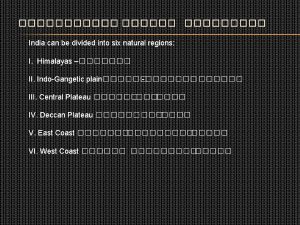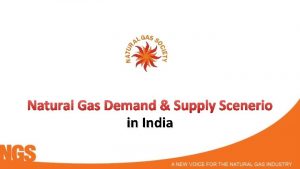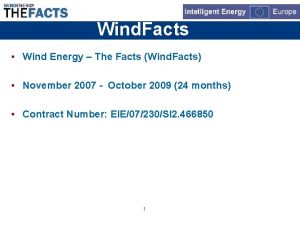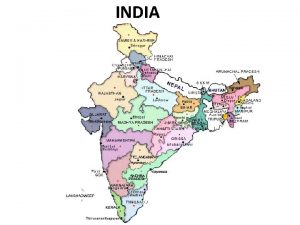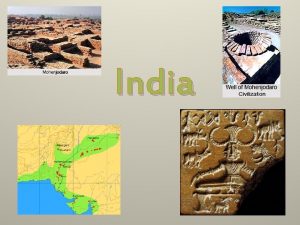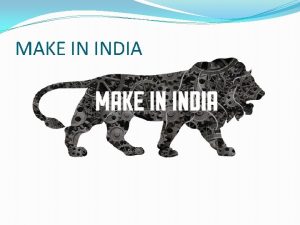Natural Gas in India Key Facts Natural Gas



















- Slides: 19

Natural Gas in India

Key Facts – Natural Gas Sector in India Today about 6% share in primary energy mix; government targets to increase it to 15% by 2030 50 -50% share of LNG and domestic gas in overall consumption in 2017 -18 Existing pipeline connectivity of over 16, 000 km; plans to increase to over 30, 000 km Several new LNG capacity addition being planned; from current capacity of ~31. 0 MTPA to 78 MTPA in 2021 -22 50% of current consumption from prime consuming sectors Power and Fertilizer, declining or stagnating CGD and industrial use growing sectors and likely to emerge as key drivers.

The 15% Vision • Current gas share in energy mix India 6. 2% World average 23% • Per capita gas consumption India 35 SCM World 441 SCM For 15% gas share, gas consumption needs to quadruple by 2030

Increasing infrastructure to support the 15% vision • Pipeline length/capacity ~17000 km/ 374 MMSCMD • Additional 15000 km pipeline coming up • Sufficient to handle about three times current consumption

LNG driving consumption; pricing holds the key • LNG imports rising 50% of consumption • LNG regas capacity current 31 MMTPA to increase to 60 -70 MMTPA • Most additionally capacity planned along East Coast LNG Capacity (MMTPA) 90 80 70 60 50 40 30 20 10 0 65 78 27 2017 -18 2019 -20 2021 -22

Rising gas consumption supporting the 15% vision • 15% growth in gas consumption since 2014 -15 ~ 145 MMSCMD • Shift in consumption pattern away from conventional segments • CGD now the fastest growing segment, holds the most potential • Refinery and petrochemicals are other two small but rising segments

CGD Prime Growth Driver of Gas Consumption • • • 17% share in overall consumption at 24 MMSCMD Over 100 % increase in no. of GAs (179) in last two years Over 50% in no. of CNG stations (1528) since 2014 -15 About 30% increase in no. of CNG vehicles since 2014 -15 at 3. 26 million About 65% increase in PNG connections since 2014 -15 at 4. 81 million CNG PNG almost equal consuming segments in sales at 45: 55

Gas demand would depend on … • Marketing and pricing freedom for natural gas • Hydrocarbon Exploration Licensing Policy (HELP) • Setting-up of Natural Gas Trading Exchange • Ban on polluting fuels such as petcoke and FO • Promotion of CNG/ LNG vehicles

LNG imports rising with/ consumption declining production Gas production / imports (mmscmd) Source: PPAC § § Declining domestic gas production is being complemented by increasing LNG imports to meet the current demand level India has 5 operating LNG Terminals importing about 20 MTPA. 11 additional terminals are being planned which will take the regas capacity to 78 MTPA by 2022 -23

LNG Infrastructure in India Source: KPMG Analysis

Pipeline Infrastructure in India Gas pipeline network (as on 1. 1. 2019) Total Length (km) Capacity (mmscmd) 16793 374 Average flow during Apr-Sep 2018 (mmscmd) 293. 4 Capacity utilisation during 2017 -18 (%) 79. 73 Gujarat CGDs § Authorisation granted for additional 14, 500 Kms of new gas pipelines Legends Existing Pipelines Under Cons. P/L – work under progress Approved P/L – work yet to start CGD Network Proposed CGD Network (105 Nos. ) on GAIL PLs Existing LNG Terminal Proposed LNG Terminal

Sector Wise Natural Gas Consumption in India Historical Gas Consumption (MMSCMD) 2011 -12 Power Fertiliser CGD Refinery Petrochemical Sponge iron Industrial Misc Total 2012 -13 2013 -14 2014 -15 2015 -16 2016 -17 2017 -18 62 38 15 12 44 40 16 11 31 43 16 11 29 42 15 13 30 44 15 14 32 42 20 15 33 40 24 18 5 4 1 29 166 7 3 1 26 148 7 1 0 25 134 8 0 1 20 128 10 1 1 15 131 11 2 2 14 139 11 4 2 13 145 Sector-wise Gas Consumption (2017 -18): 144. 75 MMSCMD § The natural gas consumption in the country has been tepid in last 5 -7 years. § Except for petrochemical and CGD sector the consumption of natural gas has not witnessed a steady trend. § Power, fertilizer, CGD, Refinery and petrochemical sector contributes to ~85 - 87 percent of the total gas consumed in the country.

CGD to be primary growth driver of gas CGD growth story 201112 Total gas consumption by CGD (mmscmd) CNG Sales PNG consumption domestic 15. 34 6. 46 8. 88 201213 15. 84 7. 17 8. 67 201314 16. 18 7. 61 8. 57 201415 14. 84 8. 04 6. 8 201516 14. 97 8. 5 6. 47 ind/com 201617 21. 19 9. 33 11. 86 1. 779 52 64 10. 081 78 CNG Stations (at March end) CNG Vehicles (million) 1010 2. 55 1081 2. 56 1233 3. 05 PNG Connections (million) 2. 94 3. 16 3. 62 Number of GAs 201718 Jan 19 24 25 10. 5 13. 5 93 179 1424 1528 3. 09 3. 26 4. 32 4. 81 § Clearly the sector has grown, both geographically and in volume terms. The significant growth in the sector has been largely due to government initiatives with the. PPAC CGD sector (CNG and PNG for residential) being accorded the highest priority for allocation of domestic gas. Source: Mo. PNG, § With 179 GAs now and 10 th round with 50 more areas is on offer, the coming years should see lot of investment in the CNG and PNG infrastructure. The sector is pegged to see an investment of Rs 70, 000 crore.

Present Future Maharashtra, Goa, Gujarat, Rajasthan, Delhi NCR, Haryana, Punjab, MP, etc

PROMOTING USE OF CNG – DEVELOPING THE INFRASTRUCTURE 80% of CNG Cluster in Maharashtra, Gujarat & Delhi-NCR LNG Terminals Existing CGD Areas

Key Drivers for Gas Demand in India 1) Upstream – Investment Reforms ü Marketing and pricing freedom for natural gas • Marketing and pricing freedom to sell at arm’s length price in the domestic market for oil and gas produced from acreages awarded under OAL (HELP) and DSF regime ü Hydrocarbon Exploration Licensing Policy (HELP) • The salient features of the policy are Open Acreage Licensing (OAL), single uniform license for conventional and unconventional hydrocarbons, simpler and easier revenue sharing contract, full freedom for marketing and market pricing for crude oil and natural gas and Low royalty rates. 2) Downstream - Market Reforms ü Setting-up of Natural Gas Trading Exchange • The government has announced setting up of a gas trading exchange in the country which will enable transparent price discovery and enable small consumers source gas as per their consumption requirement, moving away from the current rigid gas contracts 3) Clean and Sustainable Energy Reforms ü Ban on polluting fuels such as petcoke and FO • The government has banned usage of petcoke and FO in northern states of the country ü Promotion of CNG/ LNG vehicles • In order to facilitate early roll-out of CNG/ PNG network in country, Government has accorded prioritized domestic gas allocation to meet the full gas requirement of CNG and PNG (Domestic) consumer segments

Indian market deregulation Indian Gas Market is highly regulated. The gas market is regulated by the Petroleum and Natural Gas Regulatory Board (PNGRB). It was established in 2006 to regulate the refining, processing, storage, transportation, distribution, marketing and sale of petroleum, petroleum products and natural gas so as to protect consumer interest, ensure uninterrupted and adequate supply and promote competitive markets. The key functions of the Board are – • Authorize entities to lay, build, expand or operate pipelines and city gas distribution networks (CGD) • Determination of tariffs for transportation of gas in common or contract carrier pipelines and CGDs • Regulate access to pipelines and CGD as per access code, for fair trade and fostering competition amongst operating entities • Formulate and enforce service obligation for marketing entities • Prevention of restrictive trade practices • Formulation of technical standards and safety norms for construction and operation of gas infrastructure and ensuring compliance by all entities • Complaint and dispute resolution • Maintain a data bank of information on activities relating to petroleum, petroleum products and natural gas

Indian market deregulation… • Currently, the gas produced in India has a variety of different prices at the wellhead and the pricing is primarily segmented under three broad regimes: Nomination regime (also known as the Administered Pricing Mechanism or ‘APM’), Discovered Fields regime (also known as the Pre-New Exploration Licensing Policy regime or ‘Pre-NELP’), and the New Exploration Licensing Policy (NELP). § The Government is making efforts to provide marketing and pricing freedom to the gas that would be produced from the new gas field ensuring the gas produces a fair price of the gas produced and at the same time ensuring that the end consumers get the gas at affordable rates

Gas prices in India/International Domestic gas price ($/mmbtu) 3, 06 2, 5 5, 56 2, 48 6, 78 6, 3 3, 06 2, 89 3, 36 0 Nov 14 - Apr-Sep Oct 15 - Apr-Sep Oct 16 - Apr 17 - Oct 17 - Apr 18 - Oct 18 Mar 15 15 Mar 16 16 Mar 17 Sep 17 Mar-18 Sep 18 Mar 19 Domestic gas price (GCV basis) Price cap for deepwater, ultra deepwater, high temp high pressure areas International Gas/LNG prices ($/mmbtu) 12, 00 10, 00 8, 00 6, 00 4, 00 2, 00 0, 00 8 -1 де к 8 я 18 но т-1 ок 8 се н 18 г-1 ав л 18 18 ию н- 8 18 7 18 ма р18 ап р18 в- фе в- ян -1 де к я 17 7 окт-17 ноя-17 дек-17 янв-18 фев-18 мар-18 апр-18 май-18 июн-18 июл-18 авг-18 сен-18 окт-18 ноя-18 дек-18 5, 96 6, 92 7, 90 7, 05 7, 38 7, 13 7, 42 7, 32 7, 53 8, 76 9, 47 8, 76 8, 28 8, 16 2, 88 2, 98 2, 78 3, 66 2, 77 2, 94 2, 81 2, 94 2, 95 3, 23 4, 05 4, 21 8, 15 8, 23 8, 73 9, 87 9, 35 8, 82 8, 74 8, 96 9, 11 9, 47 9, 85 10, 14 10, 82 9, 96 9, 41 8, 20 9, 00 10, 20 11, 00 10, 60 8, 80 9, 10 8, 20 9, 30 10, 00 10, 70 10, 60 10, 70 10, 80 но Eurpoean spot Indictaor Henry Hub East Asian Delivered LNG indicator Japan LNG contract price ию 0 3, 82 5, 3 -1 0 6, 61 т-1 0 4, 66 ок 5 5, 05 § Gas prices have been rising, both domestically and internationally § They have to compete with alternate fuels in the consuming sectors. § Domestically, gas competes very well with alternate fuels in transport and industrial sectors. 7, 67 ма й 10
 Gas exchange key events in gas exchange
Gas exchange key events in gas exchange India interesting facts
India interesting facts Key activities
Key activities Key partners key activities key resources
Key partners key activities key resources Multiplication facts and division facts
Multiplication facts and division facts Six natural regions of india on map
Six natural regions of india on map Types of natural vegetation in india
Types of natural vegetation in india Vegetation map of india
Vegetation map of india Indus valley civilization trade and economy
Indus valley civilization trade and economy Key facts about economic fluctuations
Key facts about economic fluctuations Ideal gas vs perfect gas
Ideal gas vs perfect gas Imaginary gas
Imaginary gas Gas law
Gas law Sutherland's law
Sutherland's law Conclusion on bhopal gas tragedy
Conclusion on bhopal gas tragedy Gas leaked in bhopal gas tragedy
Gas leaked in bhopal gas tragedy Gas reale e gas ideale
Gas reale e gas ideale Flue gas desulfurisation gas filter
Flue gas desulfurisation gas filter Poisonous gas leaked in bhopal gas tragedy
Poisonous gas leaked in bhopal gas tragedy Difference between ideal gas and real gas
Difference between ideal gas and real gas





